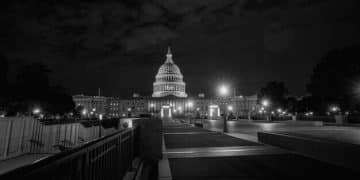New Voting Rights Act: 2025 Changes & US Election Impact

The potential New Voting Rights Act in 2025 could significantly reshape US elections by introducing federal standards for voter access, registration, and election security, directly impacting ballot box integrity and democratic participation nationwide.
The landscape of American democracy is perpetually in motion, often influenced by legislative efforts designed to either broaden or narrow voter access. As we approach 2025, the prospect of a New Voting Rights Act: What Changes in 2025 Mean for US Elections? looms large, stirring discussions nationwide. This potential legislation is not merely an incremental adjustment; it represents a significant pivot point in the ongoing debate over who votes, how they vote, and the integrity of the electoral process itself. Understanding its nuances is crucial for every citizen, as the implications could redefine the very fabric of US elections for decades to come.
The Historical Context of Voting Rights in the US
To fully grasp the significance of a New Voting Rights Act in 2025, one must first look back at the arduous journey of suffrage in the United States. The right to vote, often taken for granted in contemporary democracies, was hard-won and systematically denied to vast segments of the population for centuries. From the initial restriction to white, male property owners, the expansion of the franchise has been a continuous struggle, marked by landmark legislation and fierce opposition.
The 15th Amendment, ratified after the Civil War, ostensibly granted African American men the right to vote. However, its promise was swiftly undermined by Jim Crow laws and other discriminatory practices like poll taxes and literacy tests, particularly in the South. These tactics ingeniously circumvented the amendment’s intent, effectively disenfranchising millions. It took another century for the federal government to intervene decisively.
Landmark Legislation and Its Impact
The Voting Rights Act of 1965 (VRA) stands as perhaps the most impactful piece of civil rights legislation in American history. It outlawed discriminatory voting practices adopted in many southern states after the Civil War, especially literacy tests. Section 5 of the VRA was particularly transformative, requiring certain states and local governments with a history of voter discrimination to obtain federal preclearance before implementing any changes to their voting laws. This provision proved remarkably effective in preventing discriminatory practices before they could harm voters.
- Voting Rights Act of 1965: Eliminated discriminatory voting practices, leading to a dramatic increase in minority voter registration.
- Impact of Section 5: Prevented countless discriminatory laws by requiring federal oversight of electoral changes in historically problematic areas.
Despite its initial success, the VRA faced challenges. The Supreme Court’s 2013 decision in Shelby County v. Holder struck down Section 4(b) of the VRA, which outlined the formula for determining which jurisdictions were subject to preclearance under Section 5. This effectively rendered Section 5 unenforceable, opening the door for states to enact new voting restrictions without federal scrutiny. The years following Shelby saw numerous states implement laws, such as stricter voter ID requirements and limitations on early voting, which critics argued disproportionately affected minority voters. This historical context is vital when considering the motivations and potential mechanisms of any new voting rights legislation in 2025.
Key Provisions Expected in the New 2025 Act

The anticipated New Voting Rights Act for 2025 is not merely a hypothetical; it’s a response to evolving challenges in the American electoral system and an attempt to restore—and perhaps expand upon—the protections weakened by judicial decisions. While the specifics are still subject to legislative debate and negotiation, several key provisions are widely expected to be central to any new federal voting rights legislation. These provisions aim to address critical shortcomings in current election law and promote greater equity and access.
One of the most significant anticipated changes involves the establishment of new federal standards for voter registration. This could include provisions for automatic voter registration, where citizens are automatically registered to vote when interacting with government agencies, unless they opt out. Another related aspect is same-day voter registration, allowing individuals to register and vote on Election Day. These measures are designed to streamline the registration process and increase participation, especially among younger voters and those who frequently move.
Addressing Voter Access and Security
Beyond registration, the act is likely to address various aspects of voter access, including early voting and vote-by-mail options. Many states have expanded these options in recent years, demonstrating their effectiveness in increasing turnout. A federal standard could standardize these practices, ensuring that all eligible citizens have ample opportunities to cast their ballots, regardless of where they live. The legislation may also include provisions to combat voter suppression tactics, such as arbitrary voter purges or limitations on ballot drop boxes, which have become points of contention in recent elections.
- National Voter Registration Standards: Potential for automatic and same-day registration, aiming to simplify the process.
- Enhanced Early Voting and Mail-in Options: Federal requirements to offer extended early voting periods and accessible vote-by-mail.
- Prohibiting Discriminatory Practices: Measures to explicitly outlaw tactics that disproportionately impact minority voters or hinder access to the ballot.
Critically, any new act is expected to tackle the issue of preclearance, seeking a new mechanism to replace or circumvent the void left by Shelby County v. Holder. This could involve revised formulas for identifying jurisdictions with a history of discrimination or new tools for the Department of Justice to challenge discriminatory voting laws. Striking a balance between federal oversight and states’ rights to administer elections will be a significant challenge. Furthermore, the act may incorporate new standards for election security, including provisions for auditing election results, securing voting machines, and protecting election workers from harassment and threats. The dual emphasis on both access and security reflects the complex demands placed on modern election systems.
Impact on Voter Registration and Turnout
The potential New Voting Rights Act in 2025 could usher in a new era for voter registration and turnout in the United States. By implementing federal standards, the act aims to standardize and simplify the process of becoming a registered voter, which in many states currently presents significant hurdles. The proposed provisions for automatic voter registration (AVR) and same-day registration (SDR) are particularly transformative. AVR, where eligible citizens are automatically added to voter rolls when they interact with government agencies like the DMV, has been shown to significantly increase registration rates in states where it is already implemented. Similarly, SDR removes the burden of pre-registration, allowing individuals to register and vote on the same day, a crucial option for those who miss registration deadlines or relocate.
These changes are expected to have a broad impact, particularly on demographics that have historically faced barriers to registration. Younger voters, low-income communities, and individuals in highly migratory patterns often struggle with existing registration requirements. By making registration more seamless and accessible, the new act could lead to a substantial expansion of the eligible voting population. Furthermore, reducing the friction in the registration process often correlates with higher voter turnout, as fewer individuals are disenfranchised simply because they aren’t aware of or can’t meet registration deadlines.
Overcoming Barriers to Participation
Beyond the logistical aspects of registration, the act’s potential provisions on early voting and expanded mail-in options are designed to directly address turnout rates. Early voting periods, which can range from a few days to several weeks before Election Day, provide flexibility for voters with demanding work schedules, childcare responsibilities, or transportation issues. Vote-by-mail options, including absentee voting available to all eligible voters without excuse, further enhance convenience and reduce the need for in-person polling. The standardization of these practices across all states could mitigate the current discrepancies in access, where some states offer robust early voting and mail-in options, while others severely restrict them.
- Increased Accessibility: AVR and SDR could significantly boost the number of registered voters across diverse demographics.
- Convenience and Flexibility: Federal mandates for early voting and vote-by-mail would remove common barriers to casting a ballot.
The cumulative effect of these provisions is projected to be an increase in both voter registration and actual turnout. By making it easier to register and easier to vote, the act seeks to translate theoretical eligibility into practical participation. This could particularly impact federal elections, where even marginal increases in turnout can shift outcomes. While some critics argue that such measures might compromise election integrity or lead to fraudulent votes, proponents emphasize that accessible voting methods are crucial for a healthy democracy and that robust security measures, such as post-election audits and ballot tracking, can be implemented alongside them.
Federal vs. State Control: A Looming Battle
The debate surrounding a New Voting Rights Act in 2025 is inextricably linked with the enduring tension between federal and state control over elections. The U.S. Constitution grants states significant authority to manage elections, leading to a patchwork of diverse voting laws across the country. However, the federal government also has a constitutional role in protecting voting rights, primarily through amendments like the 14th and 15th, and legislative actions like the original VRA. Any new act will inevitably reignite arguments about the appropriate balance of power in this critical domain.
Proponents of federal intervention argue that national elections necessitate national standards to ensure uniform access and protect against discriminatory practices that might arise at the state level. They contend that a citizen’s right to vote should not be subject to the whims of individual state legislatures, especially when those whims might disproportionately affect certain groups or undermine democratic principles. A new act could impose federal minimums for voter access, early voting periods, and registration methods, effectively overriding more restrictive state laws. This perspective often emphasizes the “one person, one vote” principle and the need for federal oversight to prevent a return to Jim Crow-era disenfranchisement tactics.
Preserving State Sovereignty
Conversely, opponents of extensive federal involvement emphasize states’ rights and local control. They argue that states are best equipped to understand and manage their unique electoral landscapes, citing concerns about federal overreach and the potential for one-size-fits-all mandates to disrupt established local processes. They often highlight issues of administrative burden, cost, and the perceived threat to election integrity if federal standards dilute state-level security measures. Critics of federal intervention also argue that broad federal legislation could inadvertently open the door to voter fraud or make it more difficult for states to respond to unique local challenges. The debate becomes particularly intense when considering provisions like federal preclearance, which some states view as an infringement on their sovereignty.
- Federalists’ Stance: Advocates for national standards to protect widespread access and prevent discrimination across all states.
- States’ Rights Advocates: Prioritize local control, arguing states are better equipped to manage elections while expressing concerns about federal overreach and potential negative impacts on integrity.
The battle lines are drawn over issues ranging from voter ID laws to ballot harvesting. A new federal act would likely mandate specific types of voter identification, which could conflict with states that have either stricter or more lenient requirements. Similarly, federal provisions on ballot collection or the use of specific voting machines could clash with existing state statutes. The legal challenges to any new act would undoubtedly hinge on these constitutional questions of federal power versus state autonomy, likely culminating in Supreme Court review. The path forward for any federal voting rights legislation in 2025 will require navigating this complex and deeply entrenched political and legal terrain.
Potential Challenges and Opposition
The journey of any significant federal legislation through the U.S. Congress is fraught with challenges, and a New Voting Rights Act in 2025 would be no exception. Given its profound implications for power dynamics and electoral outcomes, such a bill would face formidable opposition from various political and ideological factions. Understanding these potential roadblocks is crucial for assessing its likelihood of passage and its ultimate impact. A primary source of opposition often stems from concerns about election integrity, although the specifics of these concerns can vary widely.
One major challenge lies in the partisan divide. Republicans, generally speaking, tend to favor state control over elections and often express concerns that federal legislation could lead to lax security measures, making voter fraud easier. They might argue that provisions like automatic voter registration or expanded mail-in voting heighten the risk of unqualified voters or duplicate ballots. Their proposals often focus on stricter voter ID laws, more frequent voter roll purges, and limitations on early voting, viewing these as essential safeguards. From their perspective, a federal act that undermines these state-level efforts is an infringement on their ability to ensure fair elections.
Legal and Practical Hurdles
Beyond the philosophical disagreements, practical and legal challenges would also emerge. Any new federal act is almost certain to face immediate legal challenges, especially regarding its constitutionality and the extent of federal power over state elections. The Supreme Court’s conservative majority could prove a significant obstacle, as evinced by the Shelby County v. Holder decision. Lawyers would scrutinize every provision, potentially leading to protracted battles that could delay or even invalidate parts of the legislation. States might also argue about the financial burden of implementing new federal mandates, particularly those related to upgrading election infrastructure or expanding voter services.
- Partisan Opposition: Deep ideological divisions, especially concerning state versus federal control and election integrity concerns.
- Judicial Scrutiny: Inevitable legal challenges to constitutionality, with a conservative Supreme Court poised to review federal overreach.
- Implementation Costs: States may resist new mandates due to the financial and logistical burden of adapting their electoral systems.
Furthermore, practical implementation issues could arise even if the act passes. States would need to overhaul existing systems, train election workers, and educate voters about new procedures. Resistance from state and local election officials due to perceived overreach or lack of resources could hinder effective implementation. Lobbying efforts from various interest groups, ranging from voting rights advocates to conservative think tanks, would intensify, further complicating the legislative process. The ultimate success of a New Voting Rights Act in 2025 will depend not just on legislative prowess but also on its ability to withstand intense scrutiny and overcome deep-seated political and legal opposition.
Implications for Future US Elections
The enactment of a New Voting Rights Act in 2025 would cast a long shadow over future U.S. elections, fundamentally altering the electoral landscape. Its implications would extend far beyond the immediate changes in voter access and registration, influencing everything from campaign strategies to the demographic composition of the electorate. The most direct impact would be on who votes and how easily they can do so. With federal standards potentially mandating automatic voter registration, expanded early voting, and accessible mail-in options, the pool of eligible and active voters could significantly broaden, particularly among historically disenfranchised groups.
This expansion of the electorate could lead to shifts in political power. Higher turnout among certain demographics might favor particular parties or candidates, compelling political campaigns to adapt their messaging and outreach strategies. Campaigns would need to engage with a larger, more diverse electorate, potentially leading to more inclusive platforms and broader policy discussions. Furthermore, by reducing barriers to voting, the act could strengthen the perceived legitimacy of election outcomes, especially if the new federal laws are widely accepted and implemented smoothly.
Redistricting and Political Representation
Another profound implication relates to redistricting and political representation. While the act itself might not directly address gerrymandering, by increasing voter participation and potentially shifting demographic turnout, it could indirectly influence future redistricting efforts. When more people vote, especially in previously marginalized communities, it can put pressure on lawmakers to draw fairer districts that more accurately reflect the population’s political will. The act could also affect the demographic representation of elected officials, creating pathways for more diverse candidates to succeed by empowering a broader segment of the electorate.
- Electoral Landscape Shift: A wider, more diverse electorate could reshape campaign strategies and political narratives.
- Enhanced Legitimacy: Increased accessibility may bolster public confidence in election results, reducing disputes.
- Indirect Impact on Redistricting: Higher, more representative turnout could pressure for fairer legislative maps.
However, the implications are not uniformly positive. The act could also intensify partisan polarization, as groups that perceive themselves disadvantaged by expanded voting access may double down on efforts to suppress turnout through other means or to challenge election results through legal or political channels. The ongoing tension between federal and state authority over elections would persist, potentially leading to continuous legal battles and legislative skirmishes over enforcement and interpretation. Ultimately, a New Voting Rights Act in 2025 has the potential to fundamentally redefine the future of American democracy, making it more inclusive and representative, but also ensuring continued fierce debate over the nation’s democratic processes.
Preparing for the 2025 Electoral Shift
As the potential for a New Voting Rights Act in 2025 moves from discussion to likely reality, various stakeholders—from voters to election officials and political parties—must prepare for the significant electoral shifts it might bring. For voters, this means staying informed about legislative developments and understanding how potential new federal standards might broaden or alter their voting options. It will be crucial to distinguish between verifiable information and political rhetoric to navigate the changes effectively. Voters should actively seek out information from reputable sources regarding new registration processes, early voting schedules, and options for casting their ballot, whether in person or by mail.
For election officials at the state and local levels, preparation involves anticipating new mandates and allocating resources accordingly. This could necessitate training staff on updated registration procedures, adjusting polling place logistics, and investing in new technology to comply with federal requirements for accessibility and security. Proactive engagement with federal agencies and legal experts will be essential to ensure smooth transitions and avoid potential compliance issues. Election officials will play a critical role in educating the public about the changes, fostering trust, and ensuring that new processes are implemented fairly and efficiently.
Adapting Political Strategies
Political parties and campaigns will also need to adapt their strategies months, if not years, in advance. A broader and potentially more diverse electorate implies that traditional voter outreach and mobilization tactics might need to be re-evaluated. Campaigns may need to invest more in grassroots organizing, community engagement, and digital outreach to reach new segments of the voting population that become more accessible under the new act. Understanding the demographic shifts in potential turnout will be key to tailoring messages and allocating resources effectively across different states and districts. This could lead to a more bottom-up approach to campaigning, emphasizing voter registration and sustained engagement rather than just last-minute get-out-the-vote efforts.
- Voter Awareness: Strong emphasis on staying informed about new registration and voting procedures.
- Official Preparedness: Election administrators must anticipate and adapt to new federal mandates, ensuring compliance and smooth operation.
- Political Realignment: Parties and campaigns should refine strategies to engage a potentially expanded and diverse electorate.
Legal teams, advocacy groups, and watchdog organizations will similarly need to brace for increased activity. Legal challenges to the act or its implementation are virtually guaranteed, requiring a robust defense of the new provisions. Advocacy groups focused on voting rights will intensify their efforts to educate voters, monitor compliance, and protect against any attempts to circumvent the new federal protections. Ultimately, preparing for the 2025 electoral shift means embracing a dynamic and potentially more inclusive democratic process, requiring vigilance, adaptability, and a commitment from all participants to uphold the fundamental right to vote.
| Key Change Area | Brief Description |
|---|---|
| 📜 Federal Standards | Establishes consistent national guidelines for voter access and election integrity. |
| ⬆️ Voter Access | Likely includes automatic and same-day registration, expanded early voting. |
| ⚖️ State vs. Federal | Intensifies debate over states’ rights vs. federal oversight in election administration. |
| 🗳️ Election Integrity | Aims to balance accessible voting with robust security measures and audit processes. |
Frequently Asked Questions About the New Voting Rights Act
▼
The primary goal is to establish comprehensive federal standards for voter access and election administration across all states. It seeks to counteract state-level restrictions and ensure uniform protections for the right to vote, addressing issues such as registration hurdles, early voting access, and combating discriminatory practices.
▼
The act is expected to mandate or encourage automatic voter registration nationwide. This means eligible citizens would be automatically registered to vote when interacting with government agencies like motor vehicle departments, unless they choose to opt out. This could significantly increase voter rolls and simplify the registration process.
▼
While voting rights acts typically focus on voter access and election administration, some proposed versions of comprehensive election reform legislation have included campaign finance provisions. However, the core of a New Voting Rights Act in 2025 is expected to concentrate primarily on ballot access, voter registration, and election security, rather than campaign finance.
▼
Opponents primarily argue that the act infringes on states’ rights to administer their own elections. Concerns also include potential impacts on election integrity, with some contending that expanded access measures like automatic registration or widespread mail-in voting could increase opportunities for voter fraud or administrative complexities.
▼
The act is widely expected to boost voter turnout, particularly by reducing barriers to registration and making voting more convenient through measures like expanded early voting and vote-by-mail. By standardizing and simplifying the electoral process, it aims to engage more eligible citizens in the democratic process, potentially shifting the composition of the active electorate.
Conclusion
The prospect of a New Voting Rights Act in 2025 embodies a crucial turning point in the ongoing evolution of American democracy. Rooted in a history of struggle for universal suffrage, this potential legislation seeks to address contemporary challenges by establishing federal standards that could profoundly reshape how U.S. elections are conducted. From streamlining voter registration through automatic and same-day options, to standardizing early voting and vote-by-mail, the envisioned act aims to enhance accessibility and participation. While it promises to expand the electorate and strengthen democratic legitimacy, it also ignites fervent debate over federal versus state control, election security, and partisan advantages. The path forward is undoubtedly complex, marked by legislative battles, legal challenges, and the necessity for extensive preparation from all stakeholders. Ultimately, the successful implementation of such an act requires a delicate balance between expanding access and ensuring integrity, reflecting a collective commitment to a robust and representative electoral system for the future of the United States.





